Study of Detection Limits of Carbonate Phases in Mixtures with Basaltic-like Fine Regolith in the MIR (1–5.5 µm) Spectral Range
Abstract
1. Introduction
2. Laboratory Methodology and Data Analysis Procedure
2.1. Sample Preparation and Creation of Laboratory Mixtures
2.2. Laboratory Spectral Measurements
2.3. Spectral Data Analysis Procedure
3. Reflectance Spectroscopy of Sample Endmembers and Mixtures
4. Analysis of Carbonate Spectral Features
4.1. Mixtures A2 Px-Basalt and PY7MM Ol-Basalt with Hydrated Dolomite
- -
- For all the studied bands, BD and BA show an increasing trend as the percent of carbonate present increases;
- -
- There are no major shifts in the BC position;
- -
- By fixing the carbonate percentage and analyzing the trend of BD and BA as a function of grain size, BD and BA seem to systematically decrease as the grain size increases for all bands visible in the mixtures;
- -
- The 1.4 µm (7143 cm−1) band is not visible in any mix;
- -
- The 1.9 µm (5263 cm−1), 2.3 µm (4348 cm−1), and 2.5 µm (4000 cm−1) bands are not visible in the mixtures at 20% with dolomite 600–710 µm and 300–400 µm; the 2.3 µm (4348 cm−1) and 2.5 µm (4000 cm−1) are not easily visible in the mix at 40% because they overlap with the basalt band. Therefore, the calculation of the spectral parameters did not give consistent values;
- -
- Bands 3.4 µm (2941 cm−1), 3.9 µm (2564 cm−1), 4.3 µm (2326 cm−1), and 4.6 µm (2174 cm−1) are not visible in 20% mixes with 600–710 µm dolomite;
- -
- The bands at 3.4 µm (2941 cm−1) and 3.9 µm (2564 cm−1) are faint in the 40% mixtures, and with 600–710 µm dolomite, it was not possible to evaluate the spectral parameters;
- -
- The bands 2.3 µm (4348 cm−1) and 2.5 µm (4000 cm−1) in the mixture at 20% and 40% with dolomite 200–224 µm are barely visible but overlap with the 2.3 µm (4348 cm−1) of A2 Px-basalt; therefore, the calculation of the spectral parameters did not give consistent values (the same in the A2 mixtures with CS11C 100–125 µm at 40%).
- -
- BD and BA show an increasing trend as the percent of carbonate present increases;
- -
- There are no major shifts in the BC position;
- -
- By fixing the carbonate percentage and analyzing the trend of BD and BA as a function of the grain size, BD and BA seem to systematically decrease as the grain size increases for all bands visible in the mixtures;
- -
- The 1.4 µm (7143 cm−1) band is not visible in any mix;
- -
- Bands 4.3 µm (2326 cm−1) and 4.6 µm (2174 cm−1) are not visible in the 20% mix with 600–710 µm dolomite.
4.2. Mixtures A2 Px-Basalt and PY7MM Ol-Basalt with Calcite
- -
- BD and BA show an increasing trend as the percent of carbonate present increase;
- -
- There are no major shifts in the BC position;
- -
- The 1.4 µm (7143 cm−1) band is not visible in pure calcite; a small 1.9 µm (5263 cm−1) band is visible in the calcite endmember spectrum, but it is small and immediately becomes undetectable in mixtures spectra;
- -
- The spectral parameters BA, FWHM, and BA/BD for the 2.8 µm (3571 cm−1) band in the mix at 80% of Py7MM and calcite are greater than the values in pure calcite. This happens because the band shape is modified by the presence of the Py7MM basalt band in that range. In fact, in the other mixtures, the band is incorporated into this structure, and it is not possible to distinguish it. However, with 80% of dolomite, the band is visible, but its shape and related spectral parameters are influenced by the basalt.
5. Summary and Implications for Mars Remote Sensing Data Analysis
Supplementary Materials
Author Contributions
Funding
Data Availability Statement
Acknowledgments
Conflicts of Interest
References
- Bridges, J.C.; Hicks, L.J.; Treiman, A.H. Carbonates on Mars. In Volatiles in the Martian Crust; Elsevier: Amsterdam, The Netherlands, 2019; pp. 89–118. [Google Scholar]
- Khan, R. The evolution of CO2 on Mars. Icarus 1985, 62, 175–190. [Google Scholar] [CrossRef]
- Pollack, J.B.; Kasting, J.F.; Richardson, S.M.; Poliakoff, K. The case for a wet, warm climate on early Mars. Icarus 1987, 71, 203–224. [Google Scholar] [CrossRef]
- Ramirez, R.M.; Craddock, R.A. The geological and climatological case for a warmer and wetter early Mars. Nat. Geosci. 2018, 11, 230–237. [Google Scholar] [CrossRef]
- Changela, H.; Chatzitheodoridis, E.; Antunes, A.; Beaty, D.; Bouw, K.; Bridges, J.C.; Capova, K.A.; Cockell, C.S.; Conley, C.A.; Dadachova, E.; et al. Mars: New insights and unresolved questions. Int. J. Astrobiol. 2021, 20, 394–426. [Google Scholar] [CrossRef]
- Steinmann, V.; Kereszturi, Á.; Mari, L. Geomorphological analysis of Tinto-B Vallis on Mars. Hung. Geogr. Bull. 2020, 69, 333–348. [Google Scholar] [CrossRef]
- Boatwright, B.D.; Head, J.W. Constraining early Mars glacial conditions from paleodischarge estimates of intracrater inverted channels. Geophys. Res. Lett. 2022, 49, e2022GL101227. [Google Scholar] [CrossRef]
- Orofino, V.; Alemanno, G.; di Achille, G.; Mancarella, F. Estimate of the water flow duration in large Martian fluvial systems. Planet. Space Sci. 2018, 300, 261–286. [Google Scholar] [CrossRef]
- Kereszturi, A. Review of Wet Environment Types on Mars with Focus on Duration and Volumetric Issues. Astrobiology 2012, 12, 586–600. [Google Scholar] [CrossRef] [PubMed]
- Grindrod, P.M.; West, M.; Warner, N.H.; Gupta, S. Formation of an Hesperian-aged sedimentary basin containing phyllosilicates in Coprates Catena, Mars. Icarus 2012, 218, 178–195. [Google Scholar] [CrossRef]
- Farmer, J.D.; Des Marais, D.J. Exploring for a record of ancient Martian life. J. Geophys. Res. 1999, 104, 26977–26995. [Google Scholar] [CrossRef]
- Kereszturi, A.; Bradak, B.; Chatzitheodoridis, E.; Ujvari, G. Indicators and Methods to Understand Past Environments from ExoMars Rover Drills. Orig Life Evol Biosph 2016, 46, 435–454. [Google Scholar] [CrossRef] [PubMed]
- Ansari, A.H. Detection of organic matter on Mars, results from various Mars missions, challenges, and future strategy: A review. Front. Astron. Space Sci. 2023, 10, 1075052. [Google Scholar] [CrossRef]
- Shawn, D.; Wright, K.E.; Adamala, K.; de La Rubia, L.A.; Bond, J.; Dartnell, L.R.; Goldman, A.D.; Lynch, K.; Naud, M.E.; Paulino-Lima, I.G.; et al. The Astrobiology Primer v2.0. Astrobiology 2016, 16, 561–653. [Google Scholar] [CrossRef]
- Murchie, S.; Arvidson, R.; Bedini, P.; Beisser, K.; Bibring, J.-P.; Bishop, J.; Boldt, J.; Cavender, P.; Choo, T.; Clancy, R.T.; et al. Compact Reconnaissance Imaging Spectrometer for Mars (CRISM) on Mars Reconnaissance Orbiter (MRO). J. Geophys. Res. 2007, 112, E05S03. [Google Scholar] [CrossRef]
- Ehlmann, B.L.; Mustard, J.F.; Murchie, S.L.; Poulet, F.; Bishop, J.L.; Brown, A.J.; Calvin, W.M.; Clark, R.N.; Marais, D.J.D.; Milliken, R.E.; et al. Orbital identification of carbonate bearing rocks on Mars. Science 2008, 322, 1828–1832. [Google Scholar] [CrossRef] [PubMed]
- Wray, J.J.; Murchie, S.L.; Ehlmann, B.L.; Milliken, R.E.; Seelos, K.D.; Noe Dobrea, E.Z.; Mustard, J.F.; Squyres, S.W. Evidence for regional deeply buried carbonate-bearing rocks on Mars. In Proceedings of the 42nd Annual Lunar and Planetary Science Conference, Woodlands, TX, USA, 7–11 March 2011. [Google Scholar]
- Morris, R.V.; Ruff, S.W.; Gellert, R.; Ming, D.W.; Arvidson, R.E.; Clark, B.C.; Golden, D.C.; Siebach, K.; Klingelhöfer, G.; Schröder, C.; et al. Identification of carbonate-rich outcrops on Mars by the Spirit Rover. Science 2010, 329, 421424. [Google Scholar] [CrossRef]
- Boynton, W.V.; Ming, D.W.; Kounaves, S.P.; Young, S.M.M.; Arvidson, R.E.; Hecht, M.H.; Hoffman, J.; Niles, P.B.; Hamara, D.K.; Quinn, R.C.; et al. Evidence for Calcium Carbonate at the Mars Phoenix Landing Site. Science 2009, 325, 61–64. [Google Scholar] [CrossRef]
- Hicks, L.J.; Bridges, J.C.; Gurman, S.J. Ferric saponite and serpentine in the nakhlite Martian meteorites. Geochim. Cosmochim. Acta 2014, 136, 194210. [Google Scholar] [CrossRef]
- Mittlefehldt, D.W. ALH84001, a cumulate orthopyroxenite member of the Martian meteorite clan. Meteorit. Planet. Sci. 1994, 29, 214221. [Google Scholar]
- Harvey, R.P.; McSween, H.Y. A possible high-temperature origin for the carbonates in the Martian meteorite ALH84001. Nature 1996, 382, 4951. [Google Scholar] [CrossRef]
- Horgan, B.H.; Anderson, R.B.; Dromart, G.; Amador, E.S.; Rice, M.S. The mineral diversity of Jezero crater: Evidence for possible lacustrine carbonates on Mars. Icarus 2020, 339, 113526. [Google Scholar] [CrossRef]
- Sagan, C.; Toon, O.B.; Gierasch, P.J. Climate change on mars. Science 1973, 181, 1045–1049. [Google Scholar] [CrossRef] [PubMed]
- Kargel, J.S.; Dougherty, A.; Feldman, W.; Hogenboom, D.; Marion, G.; McCarthy, C.; Prieto-Ballesteros, O. Hydrated Salts: Dehydration, dissolution, and incongruent melting in terrestrial evaporites and at Meridiani Planum, Mars. AGU Fall Meet. Abstracts. 2004, 2004, P21A-0205. [Google Scholar]
- Carr, M.H. The Surface of Mars; Cambridge Planetary Science Series; Cambridge University Press: Cambridge, UK, 2006. [Google Scholar]
- Kasting, J.F. CO2 condensation and the early climate of Mars. Icarus 1991, 94, 1–13. [Google Scholar] [CrossRef]
- Haberle, R.M. Early Mars climate models. J. Geophys. Res. 1998, 103, 28467–28479. [Google Scholar] [CrossRef]
- Wordsworth, R.; Forget, F.; Millour, E.; Head, J.W.; Madeleine, J.B.; Charnay, B. Global modelling of the early martian climate under a denser CO2 atmosphere: Water cycle and ice evolution. Icarus 2013, 222, 1–19. [Google Scholar] [CrossRef]
- Urata, R.A.; Toon, O.B. Simulations of the Martian hydrologic cycle with a general circulation model: Implications for the ancient Martian climate. Icarus 2013, 226, 229–250. [Google Scholar] [CrossRef]
- von Paris, P.; Grenfell, J.L.; Rauer, H.; Stock, J.W. N2-associated surface warming on early Mars. Planet. Space Sci. 2013, 82, 149–154. [Google Scholar] [CrossRef]
- Ramirez, R.M.; Kopparapu, R.; Zugger, M.E.; Robinson, T.D.; Freedman, R.; Kasting, J.F. Warming early mars with CO2 and H2. Nat. Geosci. 2014, 7, 59–63. [Google Scholar] [CrossRef]
- Ramirez, R.M.; Kasting, J.F. Could cirrus clouds have warmed early Mars? Icarus 2017, 281, 248–261. [Google Scholar] [CrossRef]
- Palumbo, A.; Head, J.W.; Wordsworth, R.D. Late Noachian Icy Highlands climate model: Exploring the possibility of transient melting and fluvial/lacustrine activity through peak annual and seasonal temperatures. Icarus 2018, 300, 261–286. [Google Scholar] [CrossRef]
- Fonti, S.; Jurewicz, A.; Blanco, A.; Blecka, M.; Orofino, V. Presence and detection of carbonates on the Martian surface. J. Geophys. Res. Planets 2001, 106, 27815–27822. [Google Scholar] [CrossRef]
- Bultel, B.; Viennet, J.; Poulet, F.; Carter, J.; Werner, S.C. Detection of Carbonates in Martian Weathering Profiles. JGR 2019, 124, 989–1007. [Google Scholar] [CrossRef]
- Blecka, M.I. A study of the influence of the surface emittance and extinction by dust on Martian IR spectra. Adv. Space Res. 1999, 23, 1613–1622. [Google Scholar] [CrossRef]
- Blecka, M.I.; Blanco, A.; Fonti, S.; Muci, A.M.; Orofino, V. Modeling the influence of surface emittance and atmospheric trasmittance on Martian spectra. Adv. Space Res. 1997, 19, 1281–1284. [Google Scholar] [CrossRef]
- Orofino, V.; Blanco, A.; Blecka, M.; de Carlo, F.; Fonti, S.; Jurewicz, A. The spectroscopic search for carbonates on the surface and in the atmosphere of mars: Laboratory measurements and numerical simulations. Adv. Space Res. 1999, 23, 1609–1612. [Google Scholar] [CrossRef]
- Carli, C.; Sgavetti, M. Spectral characteristics of rocks: Effects of composition and texture and implications for the interpretation of planet surface compositions. Icarus 2011, 211, 1034–1048. [Google Scholar] [CrossRef]
- Carli, C.; Serventi, G.; Sgavetti, M. VNIR spectral characteristics of terrestrial igneous effusive rocks: Mineralogical composition and the influence of texture. Geol. Soc. 2015, 401, 139–158. [Google Scholar] [CrossRef]
- Carli, C.; Roush, T.L.; Pedrazzi, G.; Capaccioni, F. Visible and Near-Infrared (VNIR) reflectance spectroscopy of glassy igneous material: Spectral variation, retrieving optical constants and particle sizes by Hapke model. Icarus 2016, 266, 267–278. [Google Scholar] [CrossRef]
- Mari, G. Riflettanza di Rocce di Faglia in Carbonati: Il Caso Della Faglia di Campo Imperatore (Gran Sasso, Italia). 2016. Available online: http://hdl.handle.net/20.500.12608/26566 (accessed on 15 April 2023).
- Demurtas, M.; Fondriest, M.; Balsamo, F.; Clemenzi, L.; Storti, F.; Bistacchi, A.; di Toro, G. Structure of a normal seismogenic fault zone in carbonates: The Vado di Corno Fault, Campo Imperatore, Central Apennines (Italy). J. Struct. Geol. 2016, 90, 185–206. [Google Scholar] [CrossRef]
- Traforti, A. Reactivated Fault Zones: Kinematic Complexity and Fault Rock Spectral Characterization. 2018. Available online: https://hdl.handle.net/11577/3421819 (accessed on 15 April 2023).
- Ward’s® Introductory Mineral Collection. Ward’s Science. Available online: wardsci.com (accessed on 15 April 2023).
- Maturilli, A.; Helbert, J.; Moroz, L. The Berlin emissivity database (BED). Planet. Space Sci. 2008, 56, 420–425. [Google Scholar] [CrossRef]
- Maturilli, A.; Helbert, J.; Ferrari, S.; Davidsson, B.; D’amore, M. Characterization of asteroid analogues by means of emission and reflectance spectroscopy. Earth Planets Space 2016, 68, 113. [Google Scholar] [CrossRef]
- Cloutis, E.A.; Gaffey, M.J.; Jackowski, T.L.; Reed, K.L. Calibrations of phase abundance, composition, and particle size distribution for olivine-orthopyroxene mixtures from reflectance spectra. J. Geophys. Res. 1986, 91, 11641–11653. [Google Scholar] [CrossRef]
- Clark, R.N.; Roush, T.L. Reflectance spectroscopy: Quantitative analysis techniques for remote sensing applications. J. Geophys. Res. 1984, 89, 6329–6340. [Google Scholar] [CrossRef]
- Alemanno, G.; Maturilli, A.; D’Amore, M.; Helbert, J. A new laboratory emissivity and reflectance spectral library for the interpretation of Mars thermal infrared spectral data. Icarus 2021, 368, 114622. [Google Scholar] [CrossRef]
- Gaffey, S.J. Spectral reflectance of carbonate minerals in the visible and near infrared (0.35–2.55 microns): Calcite, aragonite, and dolomite. Am. Miner. 1986, 71, 151–162. [Google Scholar]
- Clark, R.N.; King, T.V.V.; Klejwa, M.; Swayze, G. High spectral resolution reflectance spectroscopy of minerals. J. Geophys. Res. 1990, 95, 12653–12680. [Google Scholar] [CrossRef]
- Buijs, K.; Schutte, C.J.H. The infrared spectra and structures of Li2CO3 and anhydrous Na2CO3. Spectrochim. Acta 1961, 17, 927–932. [Google Scholar] [CrossRef]
- Nuevo, M.; Sandford, S.A.; Flynn, G.J.; Wirick, S. Mid-infrared study of stones from the Sutter’s Mill meteorite. Meteor. Planet. Sci. 2014, 49, 2017–2026. [Google Scholar] [CrossRef]
- Hunt, G.R.; Salisbury, J.W. Visible and near infrared spectra of minerals and rocks. II. Carbonates. Mod. Geol. 1971, 2, 23–30. [Google Scholar]
- Junfeng, J.; Yun Ge Balsam, W.; Damuth, J.E.; Chen, J. Rapid identification of dolomite using a Fourier Transform Infrared Spectrophotometer (FTIR): A fast method for identifying Einrich events in IODP Site U1308. Mar. Geol. 2009, 258, 60–68. [Google Scholar]
- Farmer, V.C. The Infrared Spectra of Minerals; Mineralogical Society: London, UK, 1974. [Google Scholar] [CrossRef]
- Hopkinson, L.; Kristova, P.; Rutt, K. The near-infrared (NIR) spectra of powdered calcite in the 3–121 μm mode particle size range. Vib. Spectrosc. 2017, 90, 69–73. [Google Scholar] [CrossRef]
- Crowley, J.K. Visible and near-infrared (0.4–2.5 lm) reflectance spectra of playa evaporite minerals. J. Geophys. Res. 1991, 96, 16231–16240. [Google Scholar] [CrossRef]
- Harner, P.L.; Gilmore, M.S. Visible–near infrared spectra of hydrous carbonates, with implications for the detection of carbonates in hyperspectral data of Mars. Icarus 2015, 250, 204–214. [Google Scholar] [CrossRef]
- Adler, H.H.; Kerr, P.F. Infrared absorption frequency trends for anhydrous normal carbonates. Am. Mineral. 1963, 48, 839–853. [Google Scholar]
- Frost, R.L.; Dickfos, M. Hydrated double carbonates—A Raman and infrared spectroscopic study. Polyhedron 2007, 26, 4503–4508. [Google Scholar] [CrossRef]
- White, W.B. The carbonate minerals. In The Infrared Spectra of Minerals; Farmer, V.C., Ed.; The Mineralogical Society: London, UK, 1974; pp. 277–284. [Google Scholar]
- Miyamoto, M.; Kato, A. Infrared diffuse reflectance spectra of some hydrous carbonates. Lunar Planet. Sci. 1990, 21, 801. [Google Scholar]
- Cloutis, E.A.; Goltz, D.M.; Coombs, J.; Russell, B.; Guertin, M.; Mueller, T. Hydrated carbonate minerals: Spectral reflectance properties and possibility of detection in martian spectra. Lunar Planet. Sci. 2000, 31, 1152. [Google Scholar]
- Applin, D.; Cloutis, E.; Izawa, M. Reflectance spectroscopy of hydrated carbonate minerals. Lunar Planet. Sci. 2014, 45, 1881. [Google Scholar]
- White, W.B. Infrared characterization of water and hydroxyl ion in the basic magnesium carbonate minerals. Am. Mineral. 1971, 56, 46–53. [Google Scholar]
- Horgan, B.H.N.; Cloutis, E.A.; Mann, P.; Bell, J.F., III. Near-infrared spectra of ferrous mineral mixtures and methods for their identification in planetary surface spectra. Icarus 2014, 234, 132–154. [Google Scholar] [CrossRef]
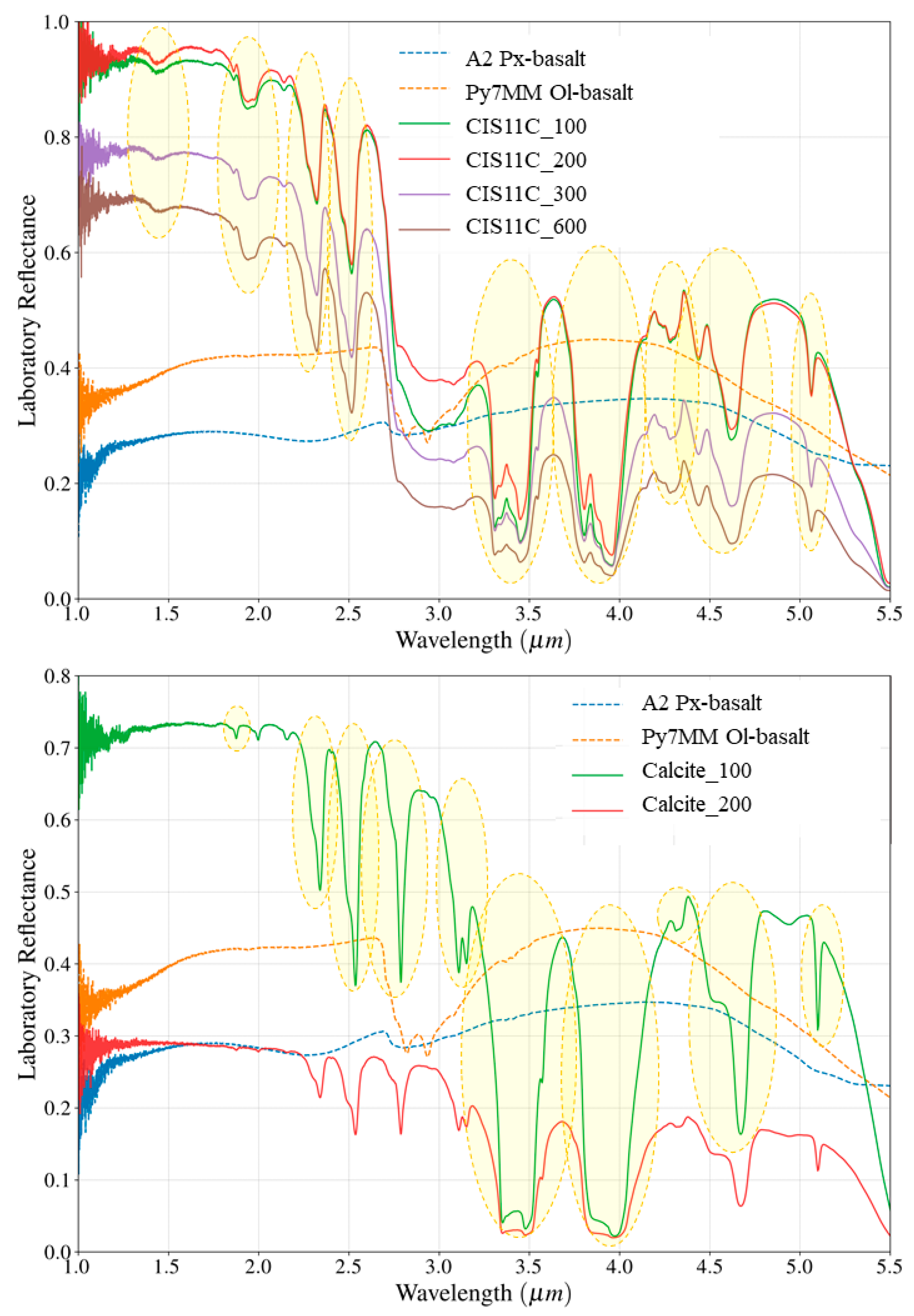
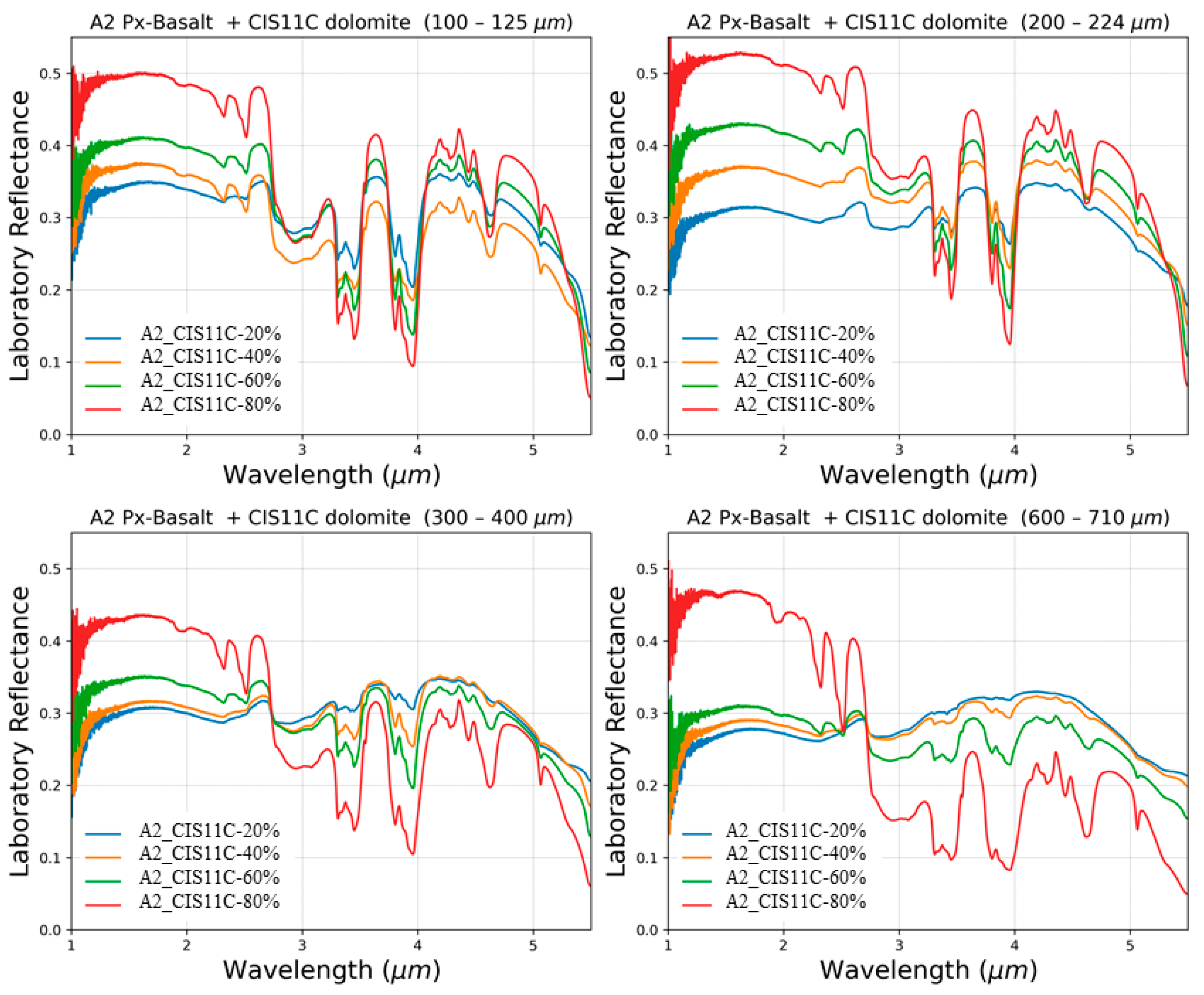
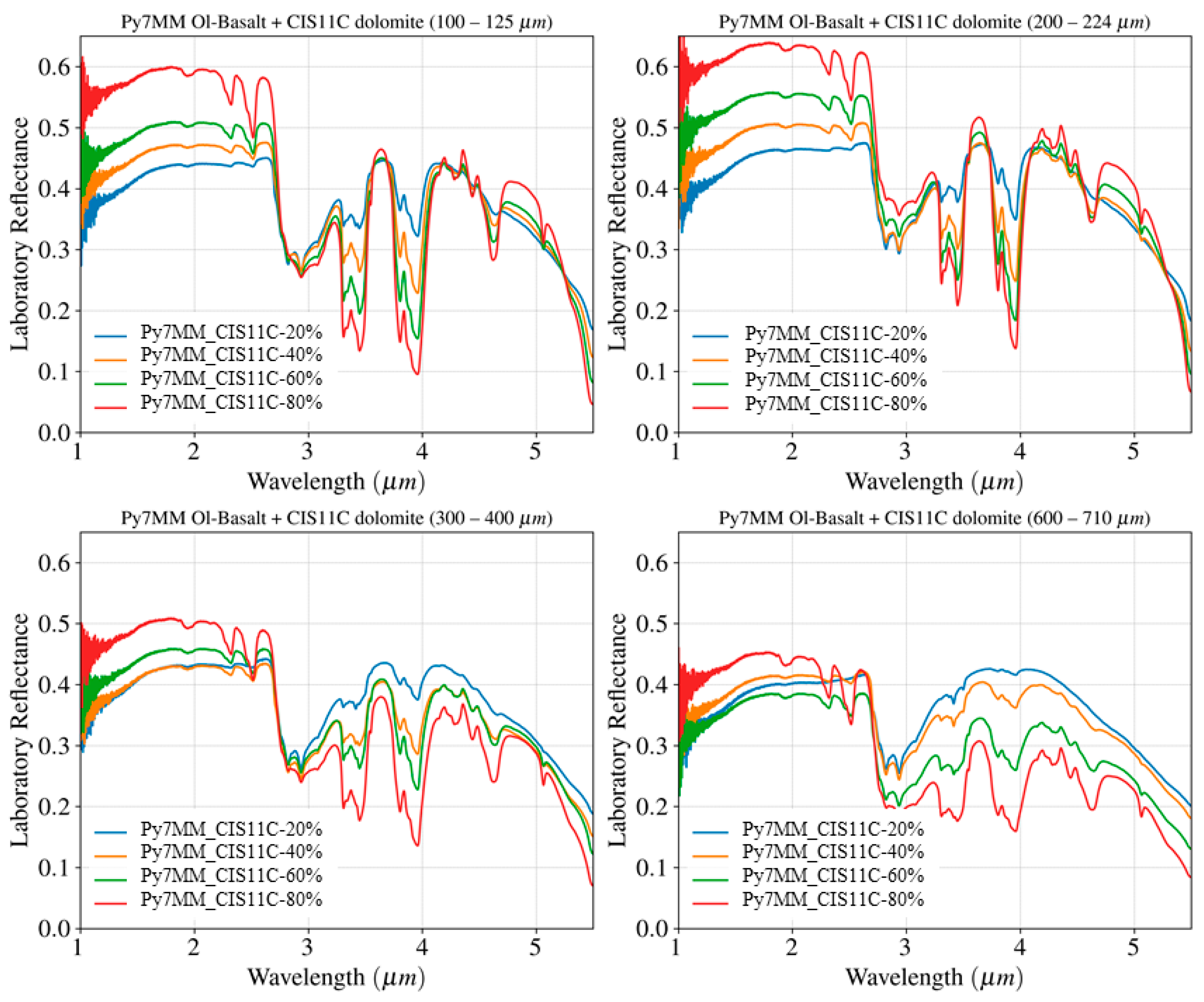
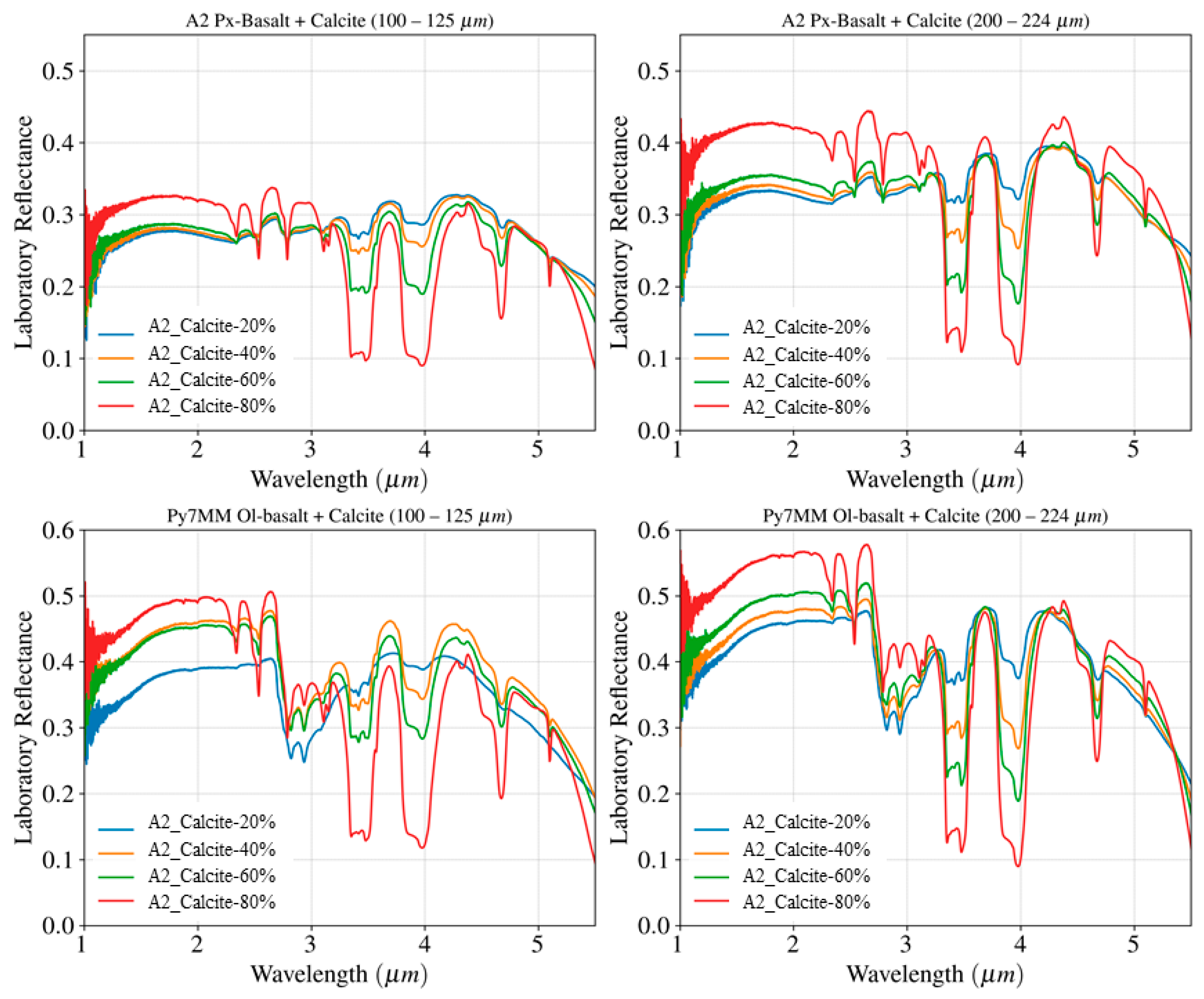
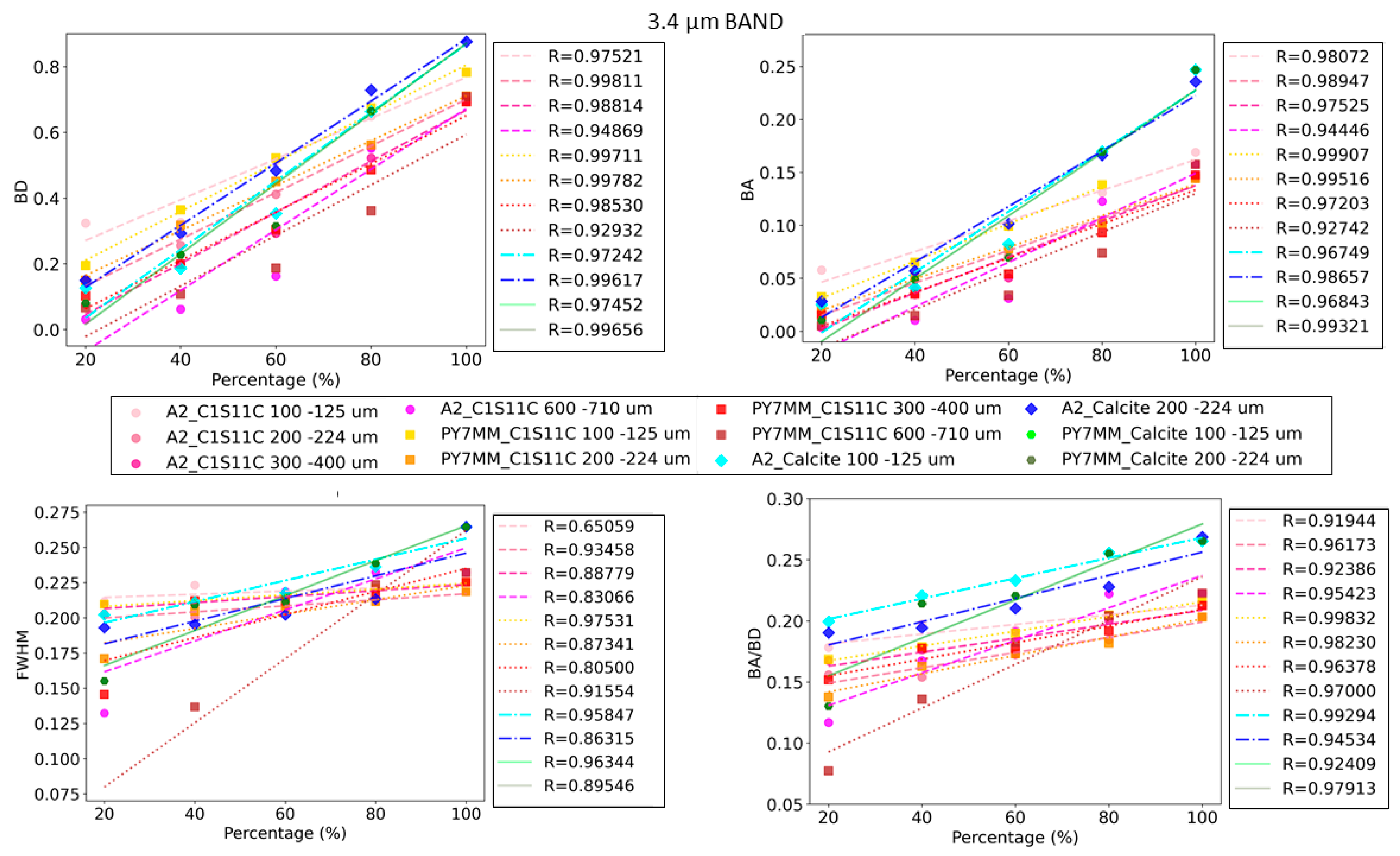
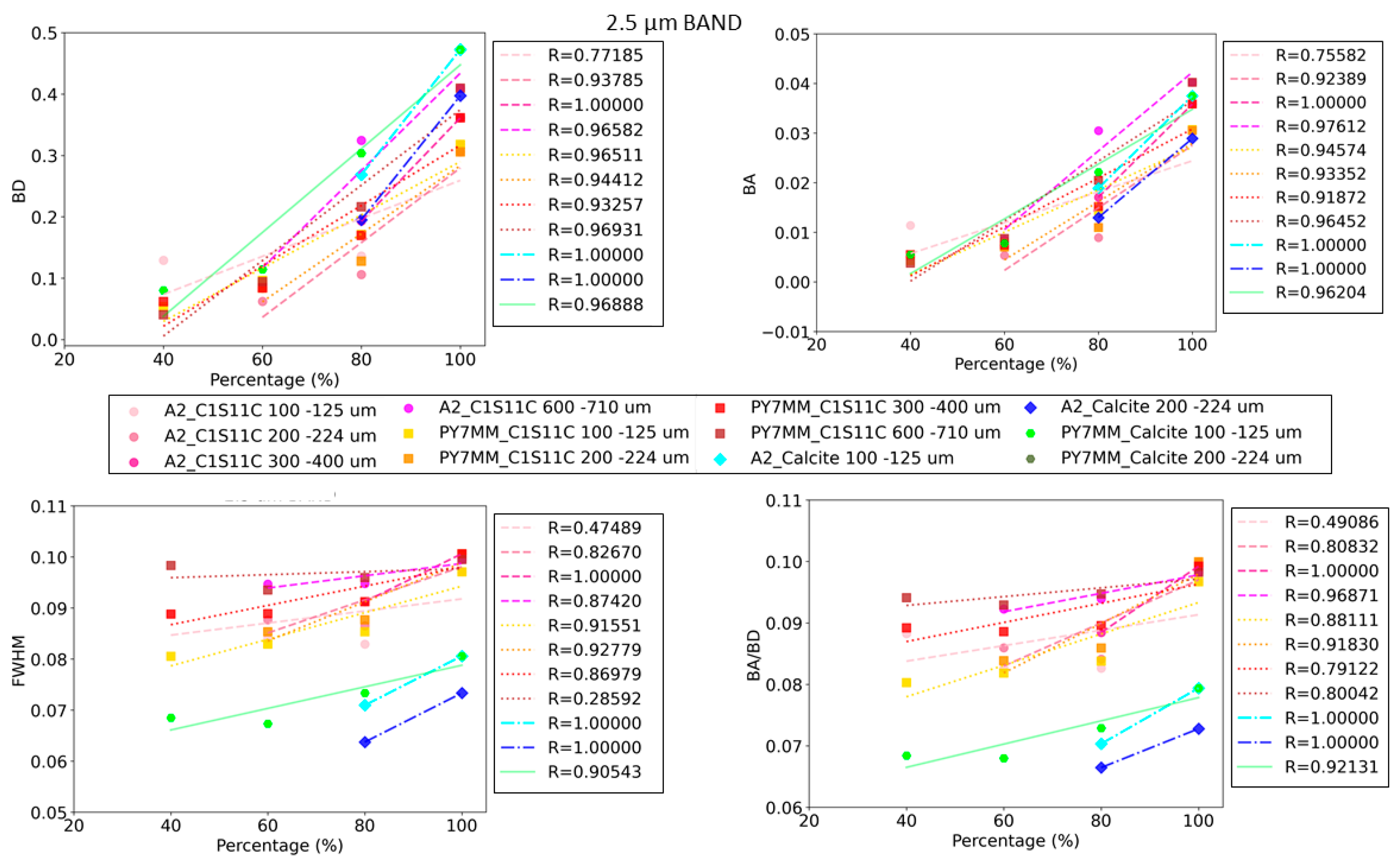
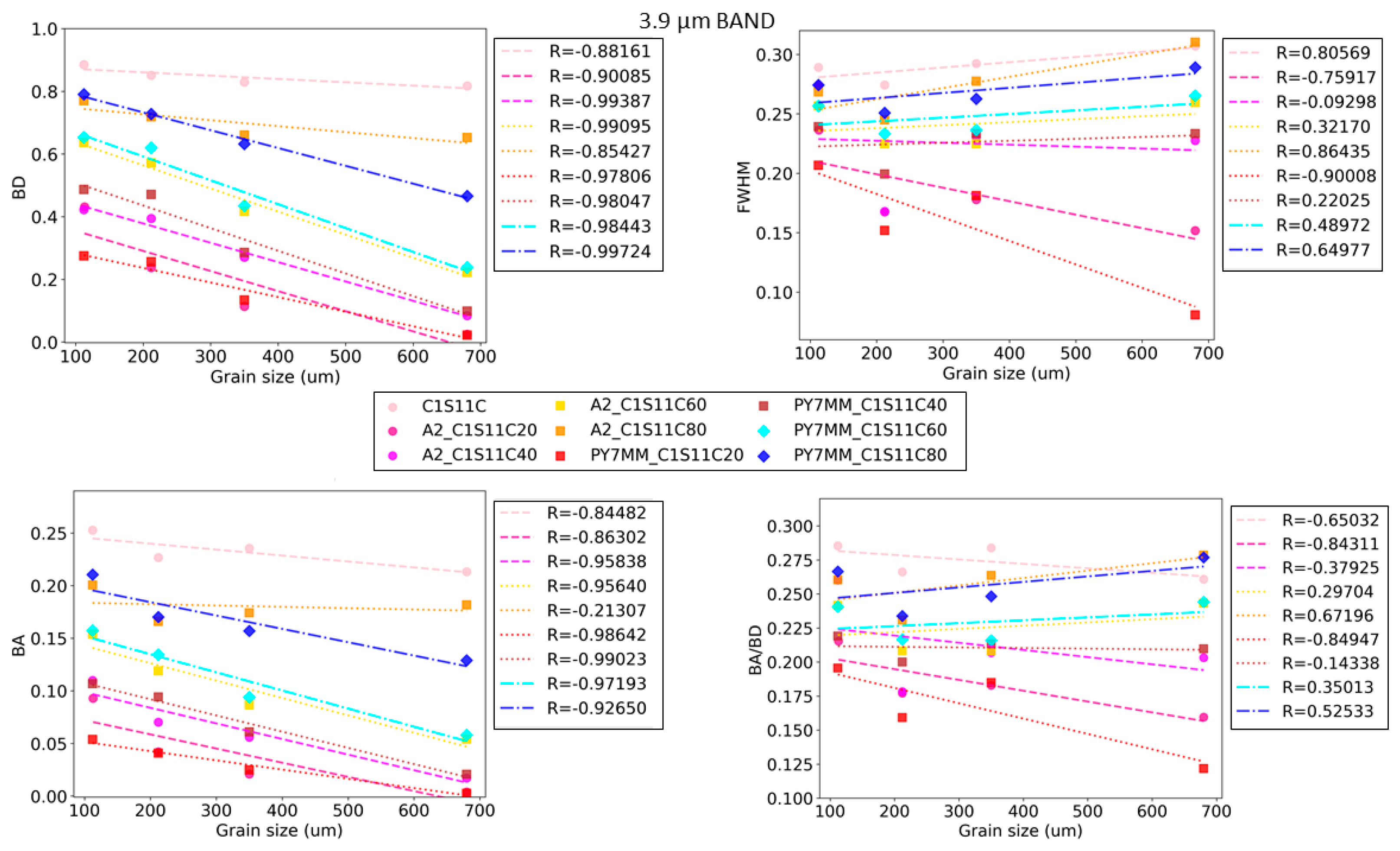
Disclaimer/Publisher’s Note: The statements, opinions and data contained in all publications are solely those of the individual author(s) and contributor(s) and not of MDPI and/or the editor(s). MDPI and/or the editor(s) disclaim responsibility for any injury to people or property resulting from any ideas, methods, instructions or products referred to in the content. |
© 2023 by the authors. Licensee MDPI, Basel, Switzerland. This article is an open access article distributed under the terms and conditions of the Creative Commons Attribution (CC BY) license (https://creativecommons.org/licenses/by/4.0/).
Share and Cite
Alemanno, G.; Carli, C.; Serventi, G.; Maturilli, A.; Helbert, J. Study of Detection Limits of Carbonate Phases in Mixtures with Basaltic-like Fine Regolith in the MIR (1–5.5 µm) Spectral Range. Minerals 2023, 13, 764. https://doi.org/10.3390/min13060764
Alemanno G, Carli C, Serventi G, Maturilli A, Helbert J. Study of Detection Limits of Carbonate Phases in Mixtures with Basaltic-like Fine Regolith in the MIR (1–5.5 µm) Spectral Range. Minerals. 2023; 13(6):764. https://doi.org/10.3390/min13060764
Chicago/Turabian StyleAlemanno, Giulia, Cristian Carli, Giovanna Serventi, Alessandro Maturilli, and Jörn Helbert. 2023. "Study of Detection Limits of Carbonate Phases in Mixtures with Basaltic-like Fine Regolith in the MIR (1–5.5 µm) Spectral Range" Minerals 13, no. 6: 764. https://doi.org/10.3390/min13060764
APA StyleAlemanno, G., Carli, C., Serventi, G., Maturilli, A., & Helbert, J. (2023). Study of Detection Limits of Carbonate Phases in Mixtures with Basaltic-like Fine Regolith in the MIR (1–5.5 µm) Spectral Range. Minerals, 13(6), 764. https://doi.org/10.3390/min13060764




